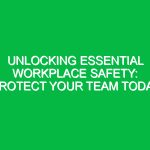Introduction
In the realm of Health, Safety, and Environment (HSE), understanding safety hazards is paramount. Safety hazards refer to conditions or practices that can lead to injury, illness, or damage to property or the environment. These hazards can arise in various forms—physical, chemical, biological, ergonomic, and psychological—and are a critical aspect of workplace safety. HSE professionals must be well-versed in identifying, assessing, and mitigating these safety hazards to ensure a safe working environment.
The significance of recognizing and managing safety hazards cannot be overstated. Every year, countless workplace accidents occur due to overlooked hazards, leading to injuries, loss of life, and financial repercussions for organizations. These incidents emphasize the need for comprehensive knowledge and proactive measures to foster a culture of safety. This article delves into the critical safety hazards every HSE professional must understand, offering insights into their implications and management strategies.
Understanding Different Types of Safety Hazards
Safety hazards can be categorized into several distinct types. Each category presents unique challenges and requires specific strategies for management. Below, we explore the major types of safety hazards relevant to HSE professionals.
1. Physical Hazards
Physical hazards are perhaps the most visible and tangible threats in any workplace. These hazards can arise from various sources, including machinery, tools, and environmental conditions. Common examples include:
- Slips, Trips, and Falls: Poor housekeeping, wet floors, or uneven surfaces can lead to falls, which are among the most common workplace injuries.
- Noise: Prolonged exposure to high noise levels can result in hearing loss and increased stress levels.
- Workplace Violence: Aggressive behaviors by coworkers or clients can create an unsafe environment.
To mitigate these hazards, HSE professionals should conduct regular inspections, implement proper training, and ensure the use of personal protective equipment (PPE).
2. Chemical Hazards
Chemical hazards involve exposure to harmful substances that can cause health issues, including respiratory problems, skin irritations, or even long-term illnesses like cancer. Examples include:
- Toxic Substances: Chemicals such as asbestos, lead, and benzene pose significant health risks.
- Flammable Materials: Improper storage or handling of chemicals can lead to fires or explosions.
- Corrosive Chemicals: Substances that can cause severe damage to living tissue or materials.
Effective management of chemical hazards involves thorough risk assessments, appropriate labeling, and ensuring that Material Safety Data Sheets (MSDS) are readily available to all employees.
3. Biological Hazards
Biological hazards are related to exposure to harmful biological agents. These can include bacteria, viruses, fungi, and other microorganisms. In environments such as healthcare, laboratories, and food service, the risk of biological hazards is heightened. Key considerations include:
- Infectious Diseases: Exposure to bloodborne pathogens or airborne diseases can pose serious health risks.
- Allergens: Biological agents can trigger allergic reactions in sensitive individuals.
- Pests: Infestations of rodents or insects can spread disease and compromise safety.
HSE professionals must implement strict hygiene protocols, vaccination programs, and pest control measures to reduce these risks.
4. Ergonomic Hazards
Ergonomic hazards arise from poor workspace design, which can lead to musculoskeletal disorders (MSDs). These hazards often go unnoticed until they result in chronic pain or disability. Key ergonomic hazards include:
- Poor Workstation Design: Improper desk height or chair design can lead to discomfort and long-term injury.
- Repetitive Motions: Tasks that require repetitive movements can strain muscles and joints.
- Heavy Lifting: Improper lifting techniques can cause serious back injuries.
To combat ergonomic hazards, employers should conduct ergonomic assessments, provide training on proper lifting techniques, and encourage job rotation to reduce repetitive strain.
5. Psychological Hazards
While often overlooked, psychological hazards can have profound impacts on employee well-being and productivity. Factors that contribute to psychological hazards include:
- Work-related Stress: High workloads, tight deadlines, and lack of support can lead to burnout.
- Harassment: Bullying or discrimination can create a toxic work environment.
- Poor Work-life Balance: Excessive work demands can interfere with personal life, leading to mental health issues.
HSE professionals should promote a supportive workplace culture, provide mental health resources, and ensure that employees have access to counseling services.
Best Practices for Identifying and Managing Safety Hazards
Recognizing and managing safety hazards is an ongoing process that requires diligence and proactive measures. Here are some best practices that HSE professionals can implement:
1. Conduct Regular Risk Assessments
Regular risk assessments are crucial for identifying potential hazards before they result in accidents. By evaluating workplace conditions, HSE professionals can pinpoint areas that require improvement. Utilizing tools such as checklists and hazard identification forms can facilitate this process.
2. Foster a Safety Culture
Creating a culture of safety involves engaging employees at all levels in safety practices. Encouraging open communication about hazards, promoting safety training programs, and recognizing safe behaviors can contribute to a positive safety culture.
3. Provide Comprehensive Training
Training is essential for ensuring that employees understand the risks associated with their jobs and how to mitigate them. Tailored training programs should address specific hazards relevant to the workplace and include practical exercises.
4. Implement Safety Protocols
Establishing clear safety protocols helps ensure that employees know the procedures to follow in case of an emergency. These protocols should be regularly reviewed and updated based on new findings or changes in the workplace.
5. Utilize Technology
Technology can greatly aid in hazard identification and management. Tools such as safety management software, incident reporting apps, and wearable technology can enhance data collection and facilitate quicker responses to identified hazards.
Regulations and Standards Governing Safety Hazards
In addition to internal policies, various regulations and standards guide the management of safety hazards. Familiarity with these regulations is essential for HSE professionals.
1. Occupational Safety and Health Administration (OSHA)
In the United States, OSHA sets and enforces standards for workplace safety, providing guidelines for hazard assessment and mitigation. Compliance with OSHA regulations is mandatory, and HSE professionals must stay updated on changes to these standards.
2. International Organization for Standardization (ISO)
ISO standards, such as ISO 45001, provide frameworks for occupational health and safety management systems. These standards help organizations improve employee safety, reduce workplace risks, and create better working conditions.
3. National Fire Protection Association (NFPA)
The NFPA develops codes and standards that address fire prevention and safety, including specific guidelines for hazardous materials. HSE professionals must ensure compliance with these standards to promote fire safety in the workplace.
Conclusion
Safety hazards are an integral aspect of the HSE domain, impacting the health and well-being of employees and the environment. By understanding the various types of safety hazards—physical, chemical, biological, ergonomic, and psychological—HSE professionals can develop effective strategies to mitigate risks and promote a culture of safety.
Implementing best practices, adhering to regulations, and fostering an environment of open communication are essential steps in managing safety hazards. The safety of an organization depends on the commitment of its professionals to prioritize health, safety, and environmental sustainability.
As we navigate the complexities of the modern workplace, continuous education and vigilance remain crucial. HSE professionals must remain proactive and adaptable, ensuring that safety hazards are identified, assessed, and managed effectively for a safer workplace.


